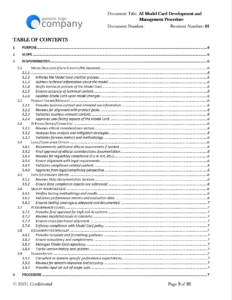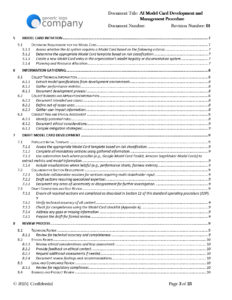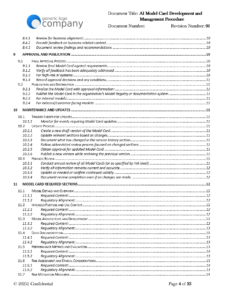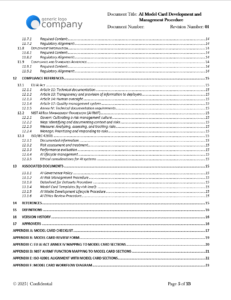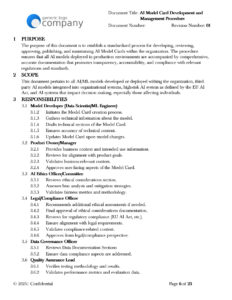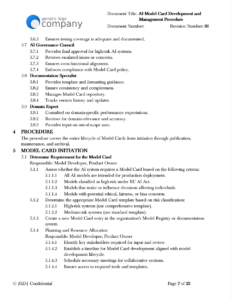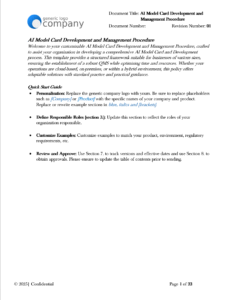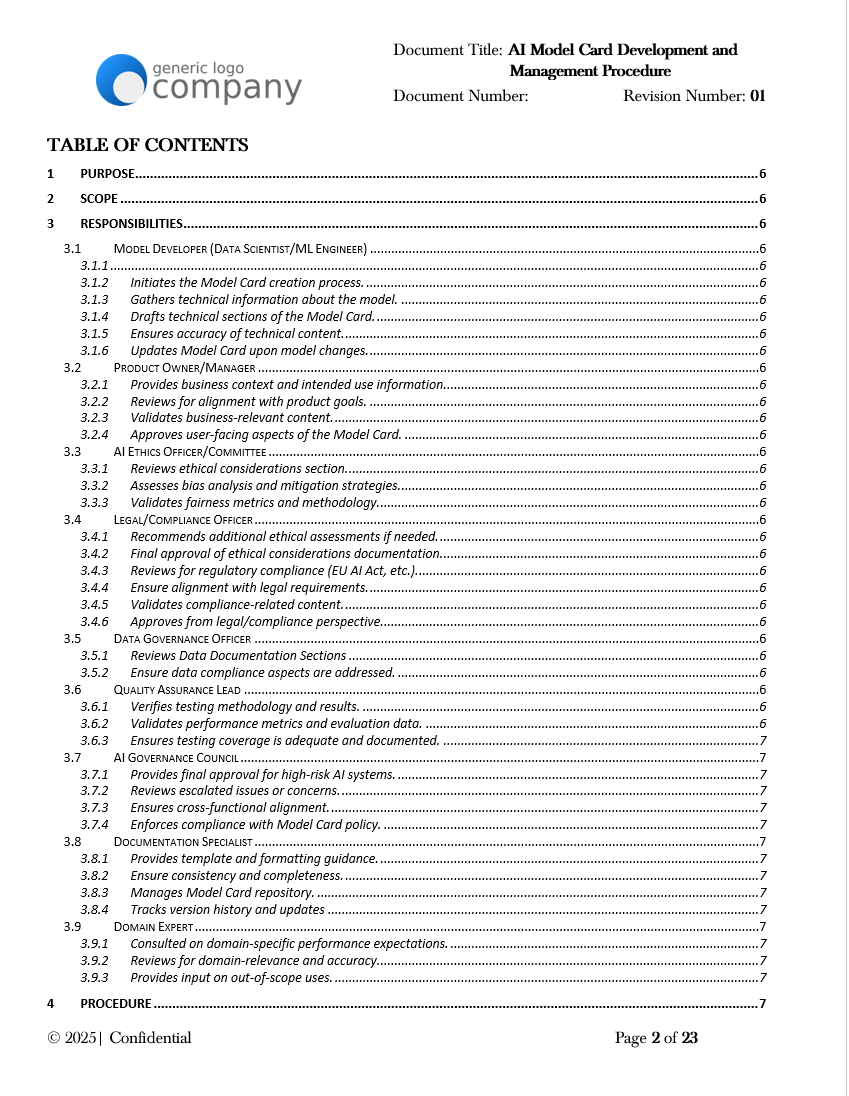
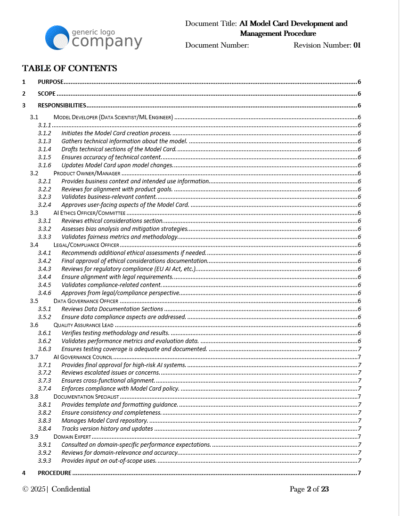
- Version
- Download
- File Size 0.00 KB
- File Count 0
- Create Date August 25, 2025
- Last Updated August 25, 2025
AI Model Card Development and Management Procedure
Subtitle: Establish a repeatable, compliance-ready workflow with the AI Model Card Development and Management Procedure for transparent and auditable model documentation.
AI Model Card Development Procedure: [Download Now]
The AI Model Card Development and Management Procedure provides organizations with a step-by-step framework for creating, managing, and maintaining model cards. By implementing this procedure, teams ensure transparency, regulatory alignment, and consistency in documenting AI models throughout their lifecycle.
Key Benefits:
-
✅ Lifecycle Coverage: From initiation through approval, publication, updates, and archival.
-
✅ Compliance Alignment: Explicitly mapped to EU AI Act Annex IV, NIST AI RMF, and ISO/IEC 42001.
-
✅ Cross-Functional Workflow: Involves data science, ethics officers, compliance, legal, and governance councils.
-
✅ Audit-Ready Documentation: Includes checklists, review forms, and regulatory mapping appendices.
-
✅ Governance Integration: Supports risk assessments, ethical reviews, and compliance verification processes.
Who Uses This?
Data science teams, compliance officers, AI ethics committees, and governance leaders requiring a standardized AI Model Card Development and Management Procedure for regulatory and operational assurance.
Why This Matters
AI regulators and frameworks increasingly require model-level documentation to support accountability, transparency, and risk management. Without a structured AI Model Card Development and Management Procedure, organizations risk fragmented documentation, compliance failures, and lack of oversight for high-risk AI. This procedure provides a repeatable governance workflow for organizations of all sizes.
Framework Alignment
This procedure aligns with:
-
EU AI Act Annex IV — Technical documentation obligations for high-risk systems.
-
NIST AI RMF — Trustworthy AI documentation requirements.
-
ISO/IEC 42001 — Governance, lifecycle, and risk treatment documentation.
-
ISO/IEC 23894 — Risk management integration.
-
OECD AI Principles — Transparency, accountability, and fairness.
Key Features
-
Defined Responsibilities: RACI for data scientists, ethics officers, compliance, legal, QA, governance councils.
-
Initiation Criteria: Identifies when a Model Card is required (production models, high-risk, retraining, scope expansion).
-
Information Gathering: Collects technical specs, datasets, training methods, use cases, risks, and user impact.
-
Draft Development: Populates structured Model Card templates with automation and performance visualizations.
-
Review Workflow: Includes technical, ethical, compliance, business, and product reviews.
-
Approval & Publication: Defines approval gates, publication in centralized repositories, and internal/external distribution.
-
Maintenance & Updates: Covers periodic reviews, incident-driven updates, version control, and archival.
-
Audit Tools: Appendices with checklists, review forms, and regulatory mapping to EU AI Act Annex IV, NIST, and ISO standards.
Comparison Table
| Feature | Generic Documentation Process | AI Model Card Development and Management Procedure |
|---|---|---|
| Lifecycle coverage | Partial | Full (initiation → updates → archival) |
| Regulatory references | None | EU AI Act Annex IV, ISO/IEC 42001, NIST AI RMF |
| Governance roles | Undefined | RACI roles for dev, ethics, compliance, QA, governance |
| Review process | Minimal | Multi-stakeholder reviews + audit trail |
| Maintenance & version control | Weak | Full update triggers, version history, repository mgmt |
| Audit-ready appendices | Absent | Checklists, forms, regulatory mappings, workflows |
FAQ Section
Q1: What is the AI Model Card Development and Management Procedure?
A: It is a structured governance procedure that defines how organizations create, review, approve, and maintain model cards across the AI lifecycle.
Q2: Which regulations and frameworks does it align with?
A: It aligns with EU AI Act Annex IV, ISO/IEC 42001, ISO/IEC 23894, and NIST AI RMF.
Q3: Does it cover review and approval workflows?
A: Yes. It includes technical, ethical, legal, compliance, and product reviews with a formal approval workflow.
Q4: Does it support audit readiness?
A: Yes. It includes appendices with checklists, review forms, regulatory mappings, and workflow diagrams.
Q5: Is it scalable for SMEs and large enterprises?
A: Yes. SMEs can use core workflows, while enterprises can integrate into MLOps pipelines, model registries, and CI/CD processes.
Q6: What format is best for using this procedure?
A: Documents are best viewed and used via Microsoft Word or Excel. Formatting may not fully display in Google Docs or other editors.
Ideal For
-
Data Science & MLOps Teams
-
AI Governance Committees
-
Legal & Compliance Teams
-
Risk & Audit Managers
-
Chief AI Officers (CAIOs)
-
Ethics & Responsible AI Leads

